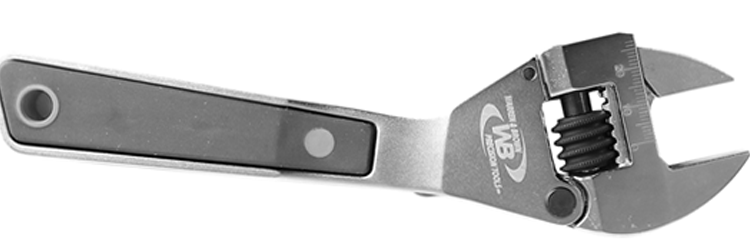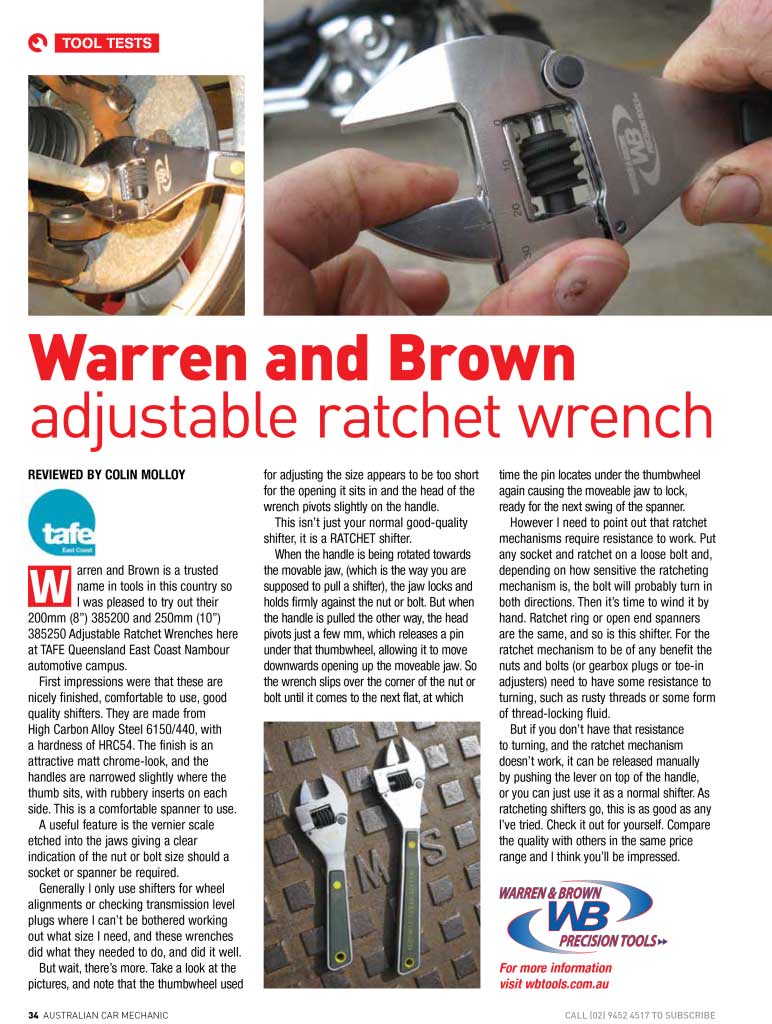Tool Test: Ratcheting Drive Spanner
Product Reviews Tool Tests - January 03, 2017

Reviewed by Colin Molloy from TAFE Queensland East Coast: Warren and Brown is a trusted name in tools in this country so I was pleased to try out their 200mm (8") 385200 and 250mm (10") 385250 Adjustable Ratchet Wrenches here at TAFE Queensland East Coast Nambour automotive campus. First impressions were that these are nicely finished, comfortable to use, good quality shifters. They are made from High Carbon Alloy Steel 6150/440, with a hardness of HRC54. The finish is an attractive matt chrome-look, and the handles are narrowed slightly where the thumb sits, with rubbery inserts on each side. This is a comfortable spanner to use.
A useful feature is the vernier scale etched into the jaws giving a clear indication of the nut or bolt size should a socket or spanner be required. Generally, I only use shifters for wheel alignments or checking transmission level plugs where I can't be bothered working out what size I need, and these wrenches did what they needed to do, and did it well. But wait, there's more. Take a look at the pictures, and note that the thumbwheel used for adjusting the size appears to be too short for the opening it sits in and the head of the wrench pivots slightly on the handle.
This isn't just your normal good-quality shifter, it is a RATCHET shifter. When the handle is being rotated towards the movable jaw, (which is the way you are supposed to pull a shifter), the jaw locks and holds firmly against the nut or bolt. But when the handle is pulled the other way, the head pivots just a few mm, which releases a pin under that thumbwheel, allowing it to move downwards opening up the movable jaw. So the wrench slips over the corner of the nut or bolt until it comes to the next flat, at which time the pin locates under the thumbwheel again causing the movable jaw to lock, ready for the next swing of the spanner.
However I need to point out that ratchet mechanisms require resistance to work. Put any socket and ratchet on a loose bolt and, depending on how sensitive the ratcheting mechanism is, the bolt will probably turn in both directions. Then it's time to wind it by hand. Ratchet ring or open-end spanners are the same, and so is this shifter. For the ratchet mechanism to be of any benefit the nuts and bolts (or gearbox plugs or toe-in adjusters) need to have some resistance to turning, such as rusty threads or some form of thread-locking fluid. But if you don't have that resistance to turning, and the ratchet mechanism doesn't work, it can be released manually by pushing the lever on top of the handle, or you can just use it as a normal shifter. As ratcheting shifters go, this is as good as any Iove tried. Check it out for yourself. Compare the quality with others in the same price range and I think you'll be impressed. Warren & Brown step by step on how to use the Ratcheting Drive Spanner:
- Tighten bolt by hand until max function is reached. Tension should be on the bolt. Bolt must not be loose!
- Position jaws around the bolt, do not lock them too tightly.
- Turn bolt and apply tension.
- Move spanner in opposite direction to activate the tension release trigger.
The spring-loaded ratcheting head will be correctly activated under tension. Read original article on ACM Magazine below or here.

